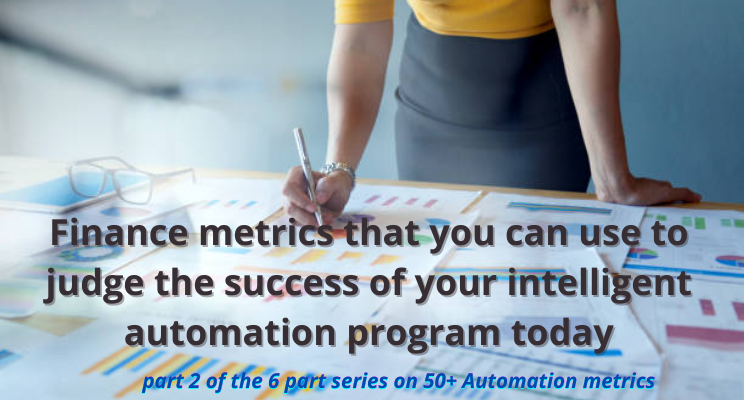An experts guide to the A-Z of all things Robotic Process Automation, Data Analytics, Intelligent Automation and Digital Transformation – the letter S
Welcome to the NINETEENTH part of a 26 part series detailing the A-Z of all things Robotic Process Automation (RPA), Data Analytics (DA), Intelligent Automation (IA) and Digital Transformation (DT). This article highlights all things relating to intelligent automation and digital transformation beginning with the letter ‘S’.
SME: A subject matter expert (SME) is a person who is an authority in a particular area or topic. An SME is someone who knows their stuff inside and out. It should be common to draw upon a subject matter expert when attempting to navigate challenges or changes within an organisation, but sadly this is not always the case.
“One of the most important members of your automation programme, despite them very rarely being a part of your actual Centre of Excellence is SME knowledge. That will be your greatest asset (and potential roadblock if they decide not to share or share everything they know). Your SME will be involved in your initial documentation, agreeing the solution, testing, and a key personal in any business owner giving you the thumbs up for your go live, treat them well, without their knowledge you will lose in the long run without their expertise.”
Wayne Butterfield, Automation Expert
Organisations often plan transformation programs in their executive teams office, These plans are often divorced from reality. When rubber hits road, a great number of bumps appear in the road and projects come unstuck. Organisations need to engage their most valuable resource (i.e. their people) when undertaking transformation programs. Engage SMEs and listen to customers as well as hiring ‘so called’ experts to have a greater chance of success.
Suppliers: Or partners? If organisations want to be successful they need partners, not just suppliers. Too often, organisations compete with the firms who supply them with software or services. They attempt to ‘win’ at negotiations, ‘win’ arguments and ‘win’ the battle over who is right. This is a path to destruction. Unless organisations and their partner businesses transparently engage and openly innovate, then both will lose. Relationships need to be ‘win win’ so that everyone walks away from the table feeling good about the partnership.
- 40 Essential Selection Criteria to Choose an RPA Platform – 5 part series
“Great partners make great businesses. Find a partner you can trust and work together as a team.”
Gourav Datta, Intelligent Automaton Director
Support: One of the biggest hidden costs of digitisation or digital transformation programs is support costs. Once a transformation program is up and running, web sites, apps, chatbots, code, technical environment and so on, all need time, cash and attention. Organisations are advised to build a business case that includes support costs and focus their attention on keeping their ‘run the business’ costs to a necessary, practicable minimum.
- How to build a business case for Intelligent Automation and Robotic Process Automation
- If your RPA program is not making money then it has failed.
- 22 way to cut the cost of an automation program
“One of the challenges of scaling your Digital Workforce is the linear growth of your support costs as your Robotic workforce grows. Support then comes in many forms, supporting your existing processes, the infrastructure that your Digital workforce is run on, and of course the wider internal costs your CoE brings as you scale up. There are new solutions coming in to take away at least some of this costs as technology manages the technology, but you still need to factor this in to your total cost of ownership.”
Wayne Butterfield, Automation Expert
Scheduling functionality – Can you set times or logic to get your robots to trigger actions? If your robots need to remain always on for a process to run, you can find that you need many robot licences (and much cost) to run many processes. Having total control over when, which and how many robots run will help your program run cost effectively. This will also provide layers of control over process completion 24/7, 365 days per year.
“While some RPA tools have easy-to-use scheduling solutions which allow you to control your resource and license usage, it’s worth considering coding a custom scheduler – outside of the RPA tool (e.g. utilising web services or RPA tool’s own API). You can then have total control over your robots’ work and avoid potential problems with low utilization of resources and licenses.”
Jan Mastalski, Lead RPA Developer
Segregation of duties: Just because organisations introduce robots does not mean that they should ignore good business risk management practices. Robots may not be able to speak or gossip in the canteen about clients but that does not mean they should be treated differently to their human counter parts when it comes to information and data security. Intelligent Automation, data analytics and digital transformation programs often come to a grinding halt when they neglect data privacy, data security and risk rules.
IA | RPA programs need to engage risk, compliance, security and audit team advices to setup and run correctly. Engage these teams before and during your organisations’ transformation programs to ensure they are being delivered correctly.
“When introducing and scaling RPA, look beyond the initial compliance effort of implementing new software tools. Each process automated needs to be assessed in context of the information and systems it accesses. Automation can’t watch an information governance video every six months, but it is an opportunity to apply strict security controls that would otherwise be prone to error when executed manually. The assessment needs to be proportionate to the potential risk profile of the process and conducted as part of the analysis effort.”
Mark Barrett, Automation Company Founder
Strategic: Forrester claims ‘scale’ remains IA | RPAs Achilles’ heel. More than half of all IA | RPA programs worldwide employ fewer than 10 bots. Fragmented automation initiatives, a patchwork of vendors, incomplete governance models, and attempts to automate overly complex tasks can stall programs. Organisations that attempt to grow their IA | RPA program must overcome process, governance, and culture obstacles. Unless IA | RPA programs are treated as strategic and have an executive sponsor, they will most likely fail to deliver a return on investment. Automation and digitisation is a long term play in support of business strategy and must be accorded all the resources, time and attention it requires to succeed.
- Do organisations now, more than ever, need to show an ROI from their automation programs?
- Can organizations implement RPA without having a digital transformation strategy?
“Start with the Executive team and get an understanding of their overarching goals for your transformation. Then use those to set milestones and goals that are achievable and measurable. As you move through your Transformation, use those goals as an opportunity for transparency. Every lesson learned and applied allows you to recalibrate your efforts and adjust expectations. Helping your team to understand the iterative process of true transformation will help you pivot quickly and maximize your innovation efforts.”
Ema Roloff, Digital Transformation Navigator
Security: Any platform that is available today must have ‘bank grade’ industry security built in by default. Organisations need to build code with ‘security by design’ in mind when they create their automation programs. Customers and clients of organisations expert to have their personal and financial data treated securely. Any security lapses will not only result in regulatory fines but in reputational damage at the hands of the ‘court of social media’. If it isn’t bank-grade security, don’t buy it.
“If your RPA platform doesn’t possess exceptional security, compliance and audit logging you have to question if that product will be suitable for your organisation.”
Gourav Datta, Intelligent Automation Delivery Lead
Scalability: To scale automation and digital programs with ROI front and centre, there are a number of pre-requisites. IA | RPA is often sold as very easy. IA | RPA is not difficult, but it is also not easy to get right either
- Establish a Centre of Expertise to regulate, promote, govern, filter and validate business cases, PR, hire – train – coach – mentor and manage IA | RPA colleague, link with IT to ensure there is a suitable enterprise platform available (my preference is Cloud platform, for agility) and support.
- Executive sponsorship – digital and automation enabled transformation requires dedicated / proactive time and money.
- Has to be a top 5 agenda item and 100% align the IA | RPA program to the businesses broader transformation goals
- Build a robust business case – one a CFO will stand over and sign off.
- Bring an intelligent automation toolkit – RPA cant do it alone – do, think, see… but automation muscle takes time so plan for this and take your time.
- Ideally streamline, redesign, standardise processes and only then digitise and automate
- Treat IA | RPA platforms as an enterprise platform – make available always.
- Build a pipeline of valuable processes
- Design for humans not machines i.e. great customer and staff experience
- Have an excellent governance model to assess, review and track process business benefits
- Develop an automation and digital mind-set – automation first mind-set.
- Hire and build a well-paid, well-trained professional team, who know the ins-and-outs of IA | RPA.
- Develop a strong working partnership with IT, InfoSec, audit, risk and compliance teams to help build securely.
- Don’t correlate scaling with the number of bots an organisation has or lines of code written. Instead use business outcomes as the barometer of success eg. savings or new incomes appearing in the P&L.
- Remember that automation and digitisation is a long term game. Therefore dedicate time and money to maintain the solutions an organisation develops and become reliant upon.
One process that tends to be missed when looking at scaling automation is the process of business scale. Scaling a virtual workforce that supports your human workforce uses a lot of capability already present. Much of the knowledge and experience required for establishing an automation Centre of Expertise is already present in existing HR, IT, management, and other teams within the business. Existing knowledge on how to scale the organisation can be effectively utilised with minimal change when viewed through an automation lens. Get your core automation team right, and they will help you apply existing resources to reduce complexity in scale.
Mark Barrett, Automation Company Founder
Start small, Many organisations try to tackle complex, long-running processes from the very start of their automation journey and quickly run into trouble. Avoid this headache and build successful momentum by starting small. Automaton and digital muscle is built up over time. There are no shortcuts in the gym and there are no shortcuts in real life, if you want to win. Start small, but think big and scale fast. Otherwise the significant returns that can be delivered, may never be realised.
“You don’t need to do Pilots, Proof of Concepts or Proof of Value to prove that RPA works – you need to do it to learn how it works for you. The first task that you automate doesn’t necessarily need to have a monetary business case. The value you will get is learning and experience that will help you scale.”
Anna Lagerhed, RPA Lead
Solutions architect: A solutions architect is a strategic designer and planner in a technology environment. She is the person in charge of leading the practice and introducing the overall technical vision for a particular solution, and should be considered a key hire. To identify, create and manage digital outcomes, many components must be built and systems managed by a variety of individuals and teams. Good solutions architects understand; computer and operating systems; infrastructure and engineering design; DevOps; Agile; system security; business analysis; database management; cloud development; web platforms and lots more. These are all essential ingredients of a successful, enterprise automation and digital transformation program and therefore all the more important to get this role hire right.
“The same way you cannot build an office without an Architect, you cannot build an entire robotics ecosystem without a Solution Designer watching over it.”
Balint Laszlo Papp, Automation and Business Analyst Expert
This article highlighted some things relating to intelligent automation and digital transformation beginning with the letter “S”. There are many ‘S’s’ organisations need to consider but what ‘S’ do you think is the most important?
#intelligentautomation #bots #rpaworks #digitaltransformation#roboticprocessautomation #rpa #cognitiveautomation #digitaldisruption#digitalworkforce #processautomation #digitalfuture #digitalstrategy
Other articles: If you like this article then you may find these articles of use also.
- How to build a business case for Intelligent Automation and Robotic Process Automation
- 30 ways to build a pipeline of processes suitable for Robotic Process Automation (RPA) and Intelligent Automation (IA)
- The biggest lie told to RPA customers – 50 robots equals success
- 40 essential selection criteria to choose an RPA platform
If this expert collection could benefit someone else tag them and share this.
Free to reuse: We are a community of RPA, Data Analytics, Digital and Intelligent Automation experts with years of real world experience. We have stories to tell and the scars to show for it.
We share our collective wisdom for free to simply provide as much value as we can to you. Therefore, if you want to post this article on your LinkedIn page then please feel free to do so. The more information we share within our community the more likely businesses are to succeed with this excellent technology set.
Further Help: If I can help you in any way please do reach out.
Note: The views expressed above are our views and not those of my employer or the employers of the contributing experts.




Leave a Reply